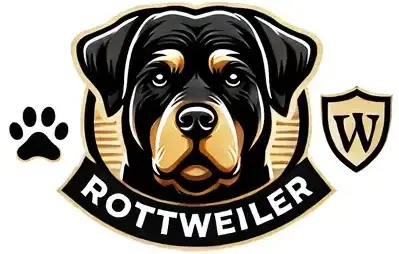Last Updated on April 24, 2024 by Dr. Julie
Rottweilers are no exception to hip dysplasia, making many owners wonder what are the symptoms of Rottweiler hip dysplasia. Unfortunately, hip dysplasia is a common occurrence with dogs, potentially causing even more orthopedic problems. This skeletal condition is more common with larger dogs, which is why Rottweilers are more susceptible to it than some smaller dog breeds.
In this article, we’ll carefully analyze exactly what hip dysplasia is, how to recognize the symptoms and how to treat it!
Table of Contents
Hip Dysplasia In Dogs
Hip dysplasia is a skeletal condition that causes the ball and the socket of a hip to malfunction. Since a hip functions on a ball-socket principle, hip dysplasia causes issues with fitting or development. This causes the bones to rub against one another, as they don’t fit at all. Normally, in a healthy dog, the bones would be smoothly working together.
Over time, this will cause major deterioration, while it’s also possible for the joint to lose complete function.
The most likely reason behind hip dysplasia is always genetics. Genetically, larger breeds, like the Rottweiler, the German Shepherd, and the Great Dane are more likely to develop hip dysplasia. Although, it’s also possible for smaller species to develop this condition, as well – it’s just less likely. A common reason for this is the excessive growth rate, while diet and exercise (or a lack thereof) can also impact your dog’s health.
Improper nutrition can harm your dog in various ways! Not only can your dog become overweight, but you can also cause excessive growth in your dog’s youth. There are specific foods that slow down your dog’s growth, ensuring that all bones slide into place while your pup is growing. Over-exercising or not exercising your dog enough can also propagate preexisting conditions like hip dysplasia, while the same applies to obesity!

Hip dysplasia in puppies, while not a common occurrence, is possible. This is why it’s important to start keeping track of their diet when they’re young!
Symptoms Of Rottweiler Hip Dysplasia
There are many symptoms that could be pointing to hip dysplasia, with some of them being more common than the others.
Sudden inactivity and disinterested behavior
Rottweilers are very active and very energetic dogs! They love exercising and movement. This is why, if you notice your dog suddenly behaving in a lazy way, it could mean that it’s in pain. Hip dysplasia is definitely a painful condition! This is why your dog might refuse to go for a walk or move at all. If this is the case, leave your dog alone for a while. If the behavior doesn’t change on its own, then you should definitely take your dog to the vet.
Even if it isn’t hip dysplasia, something else might be causing the problem and your vet will take care of it!
Nature of movement
Even if you get your dog to walk and move around, you might notice that it’s moving in an odd way. The stance of a dog with hip dysplasia is different from that of a healthy dog. It could be limping or avoiding using one of its limbs completely. If this is the case, it’s possible that the limb in question is injured. This injury could be something minor, like a thorn getting stuck in the foot. But, it could also mean something more serious, like hip dysplasia.
This is characteristically recognizable because of the ‘bunny hop’. Dogs use this technique to jump with both of their back legs simultaneously, instead of using their legs one by one.
Hip dysplasia can also cause limping or lameness. This is always a reasonable cause for concern and you should definitely take your dog to see the vet. If your dog is suffering from pain in this way, it will avoid climbing up the stairs and jumping too.
Changes in muscles
If your dog is dealing with hip dysplasia, it’s most likely going to lose muscle in the affected limb. This happens because your dog is actively trying not to use that limb. However, it can also gain muscle mass in another leg or shoulder, as it’s using it more than it used to.
Treating Hip Dysplasia
The first step towards treating hip dysplasia is determining whether your dog actually has hip dysplasia. This is done through a physical test by the vet. If your vet suspects hip dysplasia they’ll often order some blood work, as inflammation is most often obvious through the blood.
After diagnosing your dog with hip dysplasia, treatment depends mostly on your dog’s age, lifestyle, and the level of development of the condition. Sometimes, all that’s needed is a strict diet regime to take some weight off, making it easier on the hips to walk. Many vets combine this with taking various supplements and physical therapy.
Joining this to anti-inflammatory medication and a slow exercise regime can really help with hip dysplasia.
However, there are options if the dysplasia is more advanced and your dog needs surgery. The most common surgeries for this kind of condition are the double pelvic osteotomy, the femoral head osteotomy, and the complete hip replacement. However, vets won’t recommend these surgeries if it isn’t absolutely necessary.
What they will recommend is preventing hip dysplasia! Even though hip dysplasia isn’t 100% preventable, there are a few things you can do! Keep track of a healthy diet for your dog, adding supplements and exercising carefully with your dog!

In Conclusion
Hip dysplasia is a skeletal condition that usually affects larger breeds. It essentially makes the joint of any limb malfunction because the ball won’t fit in the socket properly. This condition is often propagated by an unhealthy diet, a too rigorous training regime, and mostly genetics. The symptoms often include a disinterest in physical activity, Rottweiler moving oddly, and changes in muscle mass around the limbs.
If you notice these symptoms persisting, you should definitely take your dog to see the vet. There are many things professionals can do to help your dog get relief from this pain.
Read more about Grade Three Heart Murmur In A Puppy.
